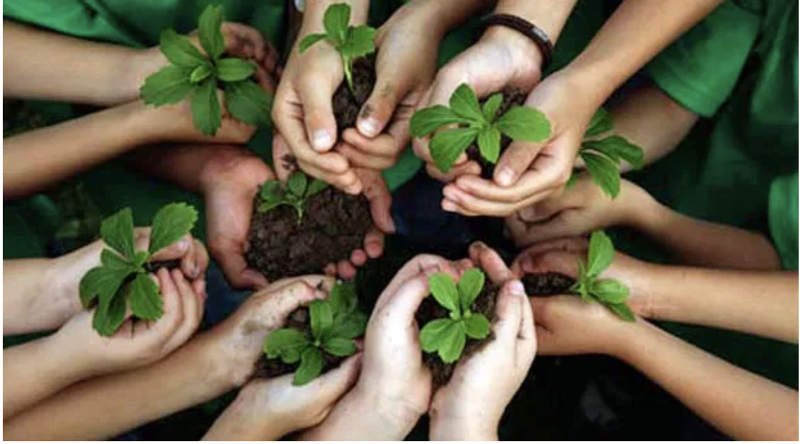Environmental conservation is a pressing issue, with climate change, deforestation, and pollution posing severe threats to our planet. The youth, comprising a significant portion of the global population, are at the forefront of addressing these challenges. Their energy, creativity, and awareness make them key drivers of change for a sustainable future. Youth have the potential to shape policies, drive technological advancements, and lead grassroots movements that can significantly impact environmental sustainability.

Importance of Youth in Environmental Conservation
1. Fresh Perspectives and Innovative Solutions
Young people bring new ideas and technological innovations to environmental conservation efforts. Their adaptability allows them to implement modern solutions, such as:
-
Renewable energy innovations (e.g., solar-powered devices, wind energy projects)
-
Sustainable urban planning (e.g., green architecture, eco-friendly transportation)
-
Digital activism through social media campaigns
-
Development of biodegradable materials to replace plastic waste
-
Use of AI and big data for climate monitoring and pollution control
2. Advocacy and Awareness
Youth have been instrumental in raising environmental awareness globally. Their role includes:
-
Organizing climate strikes (e.g., Fridays for Future movement)
-
Engaging in policy advocacy for stricter environmental laws
-
Creating digital content to educate the masses
-
Establishing school and university eco-clubs to spread awareness
-
Lobbying for climate-friendly legislation at national and international levels
3. Participation in Conservation Activities
Young people actively participate in on-ground conservation efforts such as:
-
Tree planting drives
-
Beach and park clean-ups
-
Wildlife protection initiatives
-
Restoration of degraded ecosystems
-
Community-led recycling programs
-
Waste management and composting initiatives
Challenges Faced by Youth in Environmental Conservation
| Challenge | Explanation |
|---|---|
| Lack of resources | Limited financial and infrastructural support restricts large-scale initiatives. |
| Political and institutional barriers | Some governments do not prioritize youth-led environmental policies. |
| Misinformation and lack of awareness | Many young individuals do not have access to accurate environmental education. |
| Limited involvement in decision-making | Youth are often excluded from major environmental policy discussions. |
| Resistance from corporate entities | Some businesses prioritize profits over environmental sustainability, hindering youth efforts. |
| Inadequate support from educational institutions | Schools and colleges may not integrate environmental education effectively. |
How Youth Can Contribute to Environmental Conservation
1. Adopt Sustainable Lifestyles
Youth can lead by example by integrating eco-friendly habits into their daily lives:
-
Reduce, Reuse, Recycle
-
Use energy-efficient appliances
-
Opt for sustainable fashion and consumption choices
-
Reduce carbon footprints by minimizing waste and using eco-friendly transport
-
Support ethical and environmentally friendly brands
2. Engage in Community Initiatives
Young people can contribute through:
-
Volunteering for environmental NGOs
-
Establishing local green projects
-
Educating peers about sustainable practices
-
Initiating school and college sustainability programs
-
Conducting awareness sessions in rural and urban areas
3. Leverage Technology and Social Media
The digital era empowers youth to:
-
Develop eco-friendly mobile applications
-
Create viral environmental campaigns
-
Crowdfund for conservation projects
-
Use online petitions to pressure policymakers into taking action
-
Utilize social media platforms to spread information and inspire global movements
4. Advocate for Policy Changes
Active engagement with policymakers can lead to:
-
Inclusion of climate change in school curriculums
-
Implementation of stricter environmental regulations
-
Establishment of youth-led environmental councils
-
Encouraging government subsidies for renewable energy sources
-
Promotion of corporate responsibility and green business policies
5. Pursue Careers in Environmental Fields
Encouraging youth to pursue careers in environmental sciences, sustainable engineering, and conservation can have long-term positive impacts. Career options include:
-
Environmental Scientists
-
Climate Change Analysts
-
Sustainable Development Consultants
-
Ecologists and Wildlife Biologists
-
Environmental Journalists
Case Studies: Youth Making a Difference
| Youth Leader | Initiative | Impact |
| Greta Thunberg | Fridays for Future | Mobilized millions for climate action |
| Boyan Slat | The Ocean Cleanup | Removing plastic waste from oceans |
| Leah Namugerwa | Tree planting in Uganda | Leading afforestation efforts |
| Xiuhtezcatl Martinez | Earth Guardians | Youth-led movement for climate justice |
| Melati & Isabel Wijsen | Bye Bye Plastic Bags | Advocacy for plastic ban in Bali |
Global Movements Led by Youth
The efforts of young people have led to some of the most impactful global environmental movements. Some notable movements include:
-
Fridays for Future: A youth-led global climate strike movement.
-
Zero Hour: A movement advocating for climate justice and policy reforms.
-
The Sunrise Movement: A youth-driven political organization pushing for the Green New Deal in the U.S.
-
Extinction Rebellion Youth: Focused on nonviolent protests to demand urgent climate action.
-
Youth Climate Leaders: A leadership program empowering young people to act against climate change.
Role of Education in Empowering Youth for Conservation
Educational institutions play a significant role in nurturing environmentally conscious youth. Ways in which schools and universities can contribute include:
-
Introducing comprehensive environmental science curricula
-
Organizing eco-friendly workshops and projects
-
Encouraging students to participate in sustainability challenges
-
Collaborating with NGOs for hands-on conservation experiences
-
Providing grants and scholarships for environmental research
The Future of Youth in Environmental Conservation
The future of environmental conservation is in the hands of the youth. With increasing global support, technological advancements, and digital activism, young individuals can achieve greater milestones in:
-
Restoring biodiversity
-
Implementing large-scale renewable energy projects
-
Reducing carbon emissions
-
Strengthening climate policies at international levels
Ilmkidunya
Top Contributors
Related Articles
Why Your First Job Doesn’t Define Your Career – Key Factors for Long-Term Success
- Ilmkidunya
- 14/Apr/2025








.gif)


































